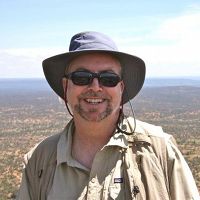Newman et al., 2010
Evapotranspiration partitioning in a semiarid woodland: ecohydrological heterogeneity and connectivity in vegetation patches
Newman B.D., Breshears D.D., and Gard M.O. (2010)
Vadose Zone Journal, 9(3): 561-572,
-
Catalina-Jemez, INVESTIGATOR
Abstract
Partitioning evapotranspiration into its evaporation and transpiration components is critical for understanding ecohydrologic processes in drylands. Existing partitioning estimates, however, have not adequately accounted for the heterogeneity associated with woody plant canopy patches and intercanopy patches so characteristic of dryland ecosystems. We measured water contents, stable isotopes (δ2H and δ18O), Cl−, and NO3 − from core samples collected during an intense drought in canopy and intercanopy patches in a semiarid, piñon–juniper [Pinus edulis Engelm.– Juniperus monosperma (Engelm.) Sarg.] woodland in northern New Mexico to assess patch-scale heterogeneity and evapotranspiration partitioning. Soil zone residence times based on Cl− ranged from 6 to 37 yr, highlighting the long time scale of percolation in these woodlands. The average NO3 − concentration was nearly seven times lower in canopy patches, indicating substantial biogeochemical heterogeneity. Average δ2H values from shallow soil (<0.1 m) were 11 to 17‰ lower in canopy patches, suggesting lower soil evaporation losses compared with intercanopy patches, however, significantly larger Cl− inventories in canopy patches indicate up to four to six times more total evapotranspiration. Taken together, lower evaporation and greater evapotranspiration suggest that canopy patches have substantially larger transpiration rates and lower evaporation/transpiration ratios than intercanopy patches. Our results support a basic but untested conceptual model of patch connectivity where woody plants utilize substantial amounts of intercanopy water that has been redistributed from intercanopy to canopy patches via hydraulic gradients created by root uptake—a finding not generally modeled but potentially relevant to globally extensive patchy-structured drylands.
Citation
Newman B.D., Breshears D.D., and Gard M.O. (2010): Evapotranspiration partitioning in a semiarid woodland: ecohydrological heterogeneity and connectivity in vegetation patches. Vadose Zone Journal, 9(3): 561-572,. DOI: 10.2136/vzj2009.0035
 This Paper/Book acknowledges NSF CZO grant support.
This Paper/Book acknowledges NSF CZO grant support.
Explore Further

